| Shakadoguchi Tunnel (釈迦堂口) |
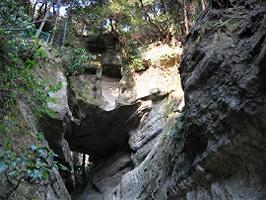
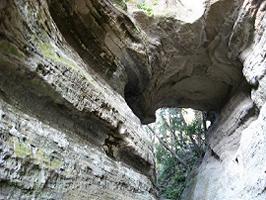
Location: 1.3 kilometers east of JR Kamakura Station
Story: Hojo Yasutoki (北条泰時, 1183-1242), the third regent in the Kamakura period, built Shakado Hall here to pray for the repose of the soul of his father, Yoshitoki (義時, 1163-1224), the second regent.
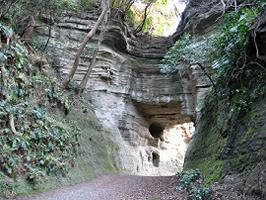
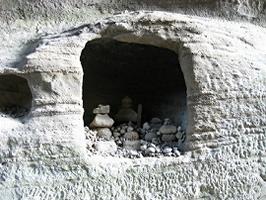
The name of this area derives from the name of the hall. Even so, the exact location of the first Shakado Hall is not known. Above and around Shakado Tunnel are many caves called yagura (やぐら), a term that refers to burial caves for warriors or priests in the Kamakura and Muromachi periods.
Two well-known caves are Karaito Yagura (唐糸やぐら) and Jitsugetsu Yagura (日月やぐら). A plaque in front of Jitsugetsu Yagura explains that the name derives from the appearance of round holes within the cave, supposedly in the shape of the sun and moon, that hold the remains of the dead. Jitsu (日) in Japanese means the sun, and getsu (月) means the moon. Both caves are now within the boundaries of a private estate and are no longer accessible to the public.
| Karaito Yagura Cave (唐糸やぐら) |
Story: A legend surrounding Karaito Yagura says that in the latter half of the twelfth century there was a souring of the relationship between Minamoto no Yoritomo and his cousin, Minamoto no Yoshinaka, a.k.a. Kiso Yoshinaka (木曾義仲, 1154-84), in Kiso (in the present-day southwestern part of Nagano Prefecture).
The two leading Genji warriors were vying for hegemony over the country in the war between the Genji and Heike, and the latter took the initiative in Kyoto. A lady by the name of Karaito (唐糸), who was also a daughter of Yoshinaka's retainer, Tezuka Taro Mitsumori (手塚太郎光盛), had been sent to Yoritomo's court ostensibly to serve him but in truth was a spy.
As such, she listened in on a conversation between Yoritomo and his vassals in which they were discussing how to destroy the Yoshinaka forces. Outraged, she attacked Yoritomo with her dagger, but failing in the attempt was thrown into a dungeon.
Meanwhile, her own daughter, Manjuhime (万寿姫), worrying how her mother was faring far from her home province, went to Kamakura, where like her mother, she also managed to attach herself to Yoritomo's court under false pretenses.
On a day when Yoritomo selected 12 dancers perform as an offering at Hachimangu Shrine, Manjuhime was among them. Her skill drew lavish praise from Yoritomo. "As a reward," he said, "I will grant whatever you wish." Whereupon Manjuhime begged for the release of her mother. Taken aback, Yoritomo nevertheless granted the request, and, amid cries of joy, Manjuhime was re-united with her mother, Karaito. Even Yoritomo, it is said, wept in sympathy, and the two women, mother and daughter, were then able to return to their home in Kiso.
| Kinubariyama Hill (衣張山) |
A hill called Kinubariyama (kinu = silk cloth, bari or hari = spread or cover) is on the east side of Shakado Tunnel. The name is said to have come from the following story. Minamoto no Yoritomo and Hojo Masako lived in Okura, and on a hot day in summer, says the story, they ordered that lengths of white silk cloth be spread over the hill to give the appearance of snow so that they could enjoy a winter-like scene.
The hill, 120.6 meters high, is one of the highest in Kamakura, and affords a panoramic view from its top. To the west is Mt. Fuji, a mountain range of the Izu Peninsula, Sagami Bay, and Oshima Island. To the east are the Miura and Boso Peninsulas. Because of residential housing, nowadays a climb up the hill is nearly impossible.
| Myohoji Temple(妙法寺) |
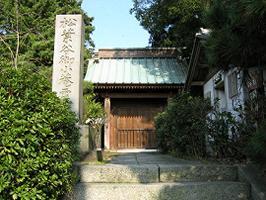
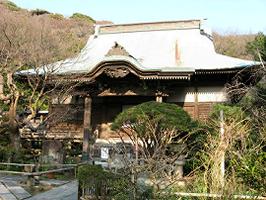
Full name: Ryogonzan Myohoji (楞厳山 妙法寺)
Denomination: Nichiren sect (日蓮宗)
Location: 1.0 kilometers southeast of JR Kamakura Station
History: In the middle of the thirteenth century, Nichiren, the founder of the Nichiren sect of Buddhism, had a hut erected in Matsubagayatsu and from there began to propagate his teachings.
The hut was attacked and set afire in 1260 by warriors and priests who harbored strong hostility toward Nichiren, who narrowly escaped with his life. This incident is referred to as the Matsubagayatsu Persecution (松葉ケ谷の法難) and has never been forgotten by the Nichiren sect followers.
According to temple tradition, the site where the hut once stood was later occupied by a temple called Honkokuji (本圀寺). Following its transfer to Kyoto in the early Muromachi period, another temple was built here by Nichiei (日叡, 1318-1400) in memory of his father, Prince Morinaga (護良親王, 1308-35, a.k.a. Moriyoshi). The name given to it was Myohoji, which was taken from Myohobo (妙法房), the name of Nichiei's dwelling.
The sango, Ryogonsan, derives from Nichiei's childhood name, Ryogommaru (楞厳丸).
Grounds and structures: The area encompassing the grounds of Myohoji, Ankokuronji (安国論寺) and Choshoji (長勝寺) is called Matsubagayatsu (松葉ケ谷), literally "Pine Needle Valley," since many pine trees once grew here.
Behind a stone gate stands a vermilion-lacquered Somon Gate (総門) with a copper-covered roof, and to the left is a stone monument, inscribed "松葉谷御小菴霊跡", which commemorates the Matsubagayatsu Persecution.
A small gate on the left of the Somon Gate serves as the entrance to the grounds, which are surrounded by trees and wooded hills beyond.
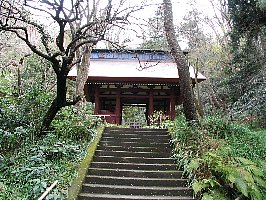
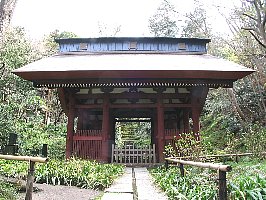
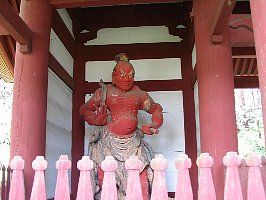
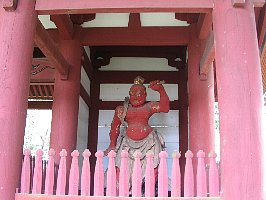
A temple office and the priest's living quarters are on the left, and the Main Hall is diagonally to the right.
The Main Hall, thought to have been built in the late Edo period by the Hosokawa family, who were daimyo (大名) in Kumamoto, houses a statue of Nichiren (a temple treasure) and statues of Shaka Nyorai and his attendants.
The sculptures, ceiling paintings and the transoms in the Hall are not open to public view but are noted for their artistry.
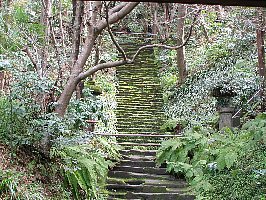
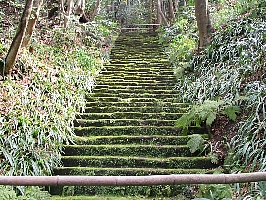
Behind the Niomon Gate to the right of the Main Hall is a flight of stone steps finely covered with moss. Thus, the temple is popularly called a "moss temple" (kokedera), much like Saihoji Temple (西芳寺) in Kyoto, which has long had the same nickname, Kokedera.
Since the steps are now closed so as to preserve the natural setting, visitors are obliged to use a newly-built stairway to the right.
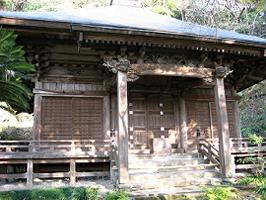
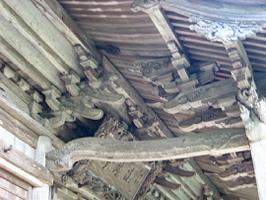
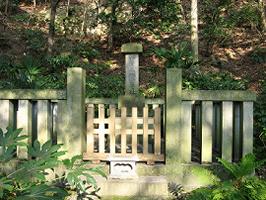
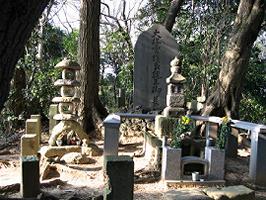
On the hillside stands a Hokkedo Hall, built by the Mito family (水戸) in the early nineteenth century. It houses Joyaku Soshizo (除厄祖師像), a Buddhist statue said to have been made by Nichiei. On the top of the hill is the former site of Nichiren's hut, and a hokyointo-type stupa for Prince Morinaga.
A "Fan Mound" (Ogizuka, 扇塚) is to the left of the Niomon Gate. Every spring, classical Japanese dance masters hold a requiem service here for their fans in appreciation for their roles, and pray for progress in their dancing skill.
| Ankokuronji Temple (安国論寺) |
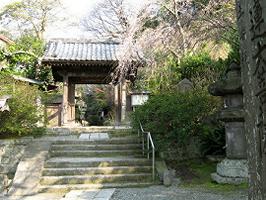
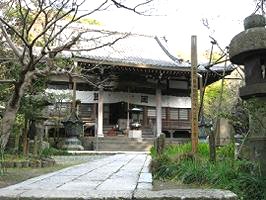
Full name: Myohozan Ankokuronji (妙法山安国論寺)
Denomination: Nichiren sect (日蓮宗)
Location: 1.1 kilometers southeast of JR Kamakura Station
History: In 1253, at Mt. Kiyosumi (清澄山, in present-day Chiba Prefecture) Nichiren proclaimed his own doctrine, which later came to be known as the Nichiren sect or Hokke sect (法華宗). He began its propagation to save people from their suffering. Because Kamakura was the center of the country at that time, he saw it as the best place to spread his teaching.
At first, people did not understand his message and they would interrupt him by pelting him with stones as he preached from street corners. No one, of course, was willing to offer him lodgings. He thereupon found a cave, converted it into a "preaching hall," and continued his proselytizing from there.
The cave, now called Gohokutsu Cave (御法窟). is said to be the place where Nichiren wrote his major work, the Rissho Ankokuron (立正安国論), A Treatise on Pacifying the Nation by Establishing Orthodoxy.
A temple built close to the cave by Nichiro (日朗, 1245-1320), Nichiren's first disciple, gradually evolved into the present Ankokuronji, although at that time it was known as Ankokuronkutsuji (安国論窟寺) and Nichiren was naturally designated the founding priest.
In spite of the temple's long history, the Main Hall (also called Soshido) and the main image of Nichiren are products of later centuries.
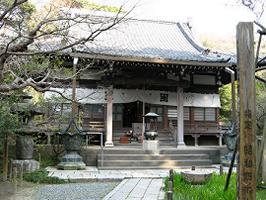
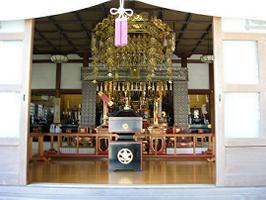
Grounds and structures: This temple is yet another that claims the Matsubagayatsu Persecution took place within its grounds; for a stone monument with the inscription "日蓮上人草菴跡" marks an alleged former site of the hut where Nichiren once lived.
Along the left side of the a stone-paved approach stand stone lanterns that belonged to the Tokugawa and were transferred from Zojoji Temple (増上寺) in Tokyo.
At the end of the approach is Founder's Hall (Soshido Hall) which also serves as the Main Hall. To its front and on the left is the priest's living quarters.
A pavilion, called Goshoan (御小庵), is directly in front of the Main Hall and is linked to a cave by a corridor. Goshoan is said to have been donated by the Owari (尾張, the present-day western part of Aichi Prefecture) branch of the Tokugawa family in the late seventeenth century. Housed within are a statue of Nichiren writing the Rissho Ankokuron, and statues of Kishimojin, Nichiro, and Daikokuten (大黒天).
In front of the Goshoan stands a cherry tree called Myoho-sakura or --zakura (妙法桜,) which supposedly grew miraculously from Nichiren's walking stick. Whatever the origin, the tree is a rare species and still blooms fully each spring.
To the right front of the cave is a shrine called Kumao Inari Daimyojin Sonden (熊王稲荷大明神尊殿). It is dedicated to Kumao-maru (熊王丸), a follower of Nichiren, and to Inari, a god in which Kumao-maru had deep faith.
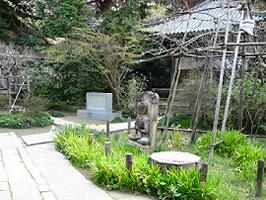
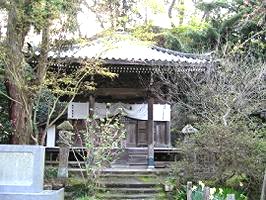
Steep stone steps from Kumao Inari Shrine lead to a spot called Fujimidai, "富士見台, Mt. Fuji Viewing Point," from where Nichiren is said to have chanted sutras in the direction of Mt. Fuji every day. In modern times, visitors simply enjoy the views of the city, Mt. Fuji and the Hakone mountain range in the distance.
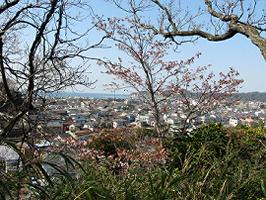
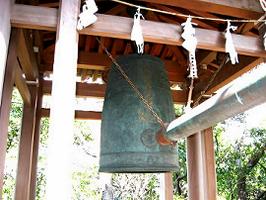
Further along a ridge is a bell tower. A bronze bell, made in hopes of world peace, hangs within and is called Rissho Ankoku no Bonsho, a name based on the title of Nichiren's famous work. It was cast by Katori Masahiko (香取正彦), a Living National Treasure. The inscription on the bell, Odaimoku to Risshoankoku, "お題目と立正安国," was taken from a handwritten passage in a tome by Nichiren.
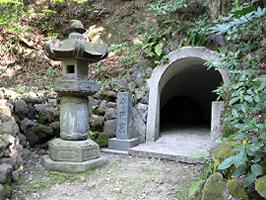
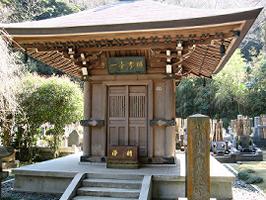
From the bell tower, a path leads upward and then downward to a cave called Nammenkutsu, (南面窟, the South-faced Cave), which is reputedly the place where Nichiren, led by a group of white monkeys, took refuge when he was attacked by his enemies. The monkeys are said to be the messengers of Sanno Gongen (山王権現 also Taishakuten, 帝釈天).
Stone statues of these monkeys, made in praise of their deed, sit in front of the cave. One is depicted guiding Nichiren by his sleeve, another offering him food.
Following the attack, Nichiren escaped to Hoshoji Temple (法性寺) on the border between Kamakura and Zushi.
A graveyard nearby Nammenkutsu Cave is the site where Nichiro Shonin was cremated and is called Nichiro Shonin On-Dabisho, (日朗上人御荼毘所, Cremation Site of Nichiro). Nichiro, having dedicated himself to the building of this temple, had left a will in which he requested that he be cremated and buried here, where he had taken the tonsure to become a disciple of Nichiren.
A path that runs parallel to the main road in front of the temple has been used from olden times. Standing on it on raised ground on the left as the road approaches the railroad crossing of the Yokosuka Line is an old and rare koshinto-type monument that bears the characters Hokuto-Sonsei (北斗尊星).
| Choshoji Temple(長勝寺) |
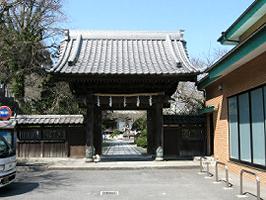
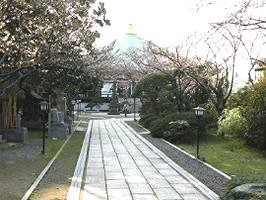
Full name: Ishiisan Choshoji (石井山長勝寺)
Denomination: Nichiren sect (日蓮宗)
Location: 1.1 kilometers south-southeast of JR Kamakura Station
History: According to tradition, a temple called Honkokuji (本圀寺) once stood here. Ishii Nagakatsu (石井長勝), a nobleman in the area and an ardent believer in Nichiren, had offered him a hermitage on his premises after Nichiren returned to Kamakura from exile in Izu.
In time, the hermitage evolved into a temple called Honkokuji. The grounds were abandoned after Honkokuji was moved to Kyoto, but the temple was later restored by Nichijo (日静), a priest, and, in recognition of Ishii's devotion to Nichiren, Ishisan was made the temple sango, and Choshoji (another reading of Nagakatsu's name) was made the temple name.
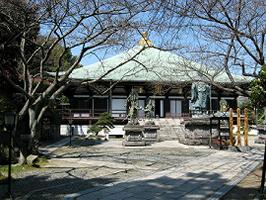
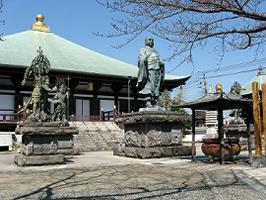
Grounds and structures: Like several other temples, Choshoji also claims to be the site of the Matsubagayatsu Persecution of Nichiren.
Beyond a vermilion gate stands another gate to the right, this one called Sammon Gate (山門), to the right. Its beams have elaborate carvings of elephants and Chinese lions, with the latter also found in the space between the beams.
Within the grounds are, in the center, a newly-built hall called Taishakudo (帝釈堂), and on raised ground to the left, Founder's Hall (also called Hokke Sammaido, 法華三昧堂).
Taishakudo Hall contains a smaller wooden pagoda called tahoto (多宝塔), which in turn holds a statue of Taishakuten. This Taishakuten came to be enshrined here because of its association with the white monkeys who are the messengers of this god and who saved Nichiren in his hour of need.
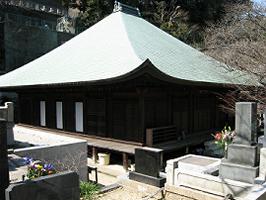
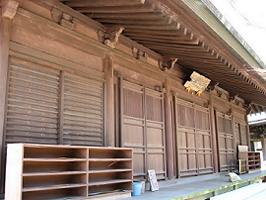
Founder's Hall was built in the Muromachi period, but in a style called Gokendo (五間堂) which is particular to the Kamakura period, and is the oldest hall in this style in the Kanto region.
The hall houses a statue of Nichiren, a large gomadan (護摩壇, made in the late Kamakura period), used as a platform in the gomahoyo ceremony (護摩法要, a rite of lighting a sacred fire for invocation) with elaborately carved petals of lotus flowers; waniguchi (鰐口, a type of gong hung under a beam), and kemban (懸盤, a table on which utensils in a Buddhist ceremony are laid out).
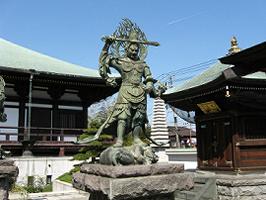
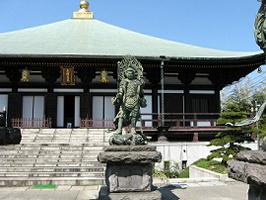
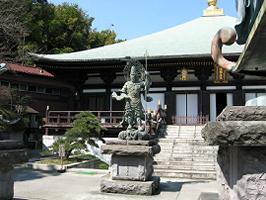
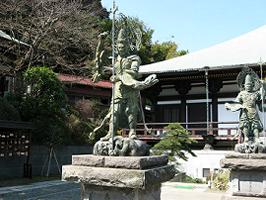
In front of Taishakudo Hall stands an eight-meter-tall statue of Nichiren (including the pedestal) made by Takamura Koun (高村光雲, 1183-1956) surrounded by four gods, or Shitenno (the Four Deva Kings or Four Heavenly Kings, 四天王): Jikokuten (持国天, guardian of the east Buddhist world), Zochoten (増長天, south), Komokuten (広目天, west), and Tamonten (多聞天, or Bishamonten, 毘沙門天, north).
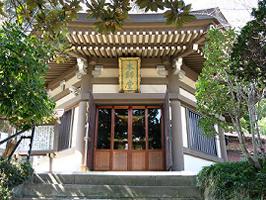
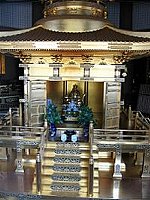
To the left of Taishakudo Hall, is a newly-built octagonal structure housing a golden statue of Shakyamuni from Thailand.
To the right of Taishakudo Hall is a small hexagonal building with a tablet under the front eaves inscribed "久遠" (Eternity), and a multi-layered stone monument.
Recent excavation revealed a number of street stalls within the grounds of Choshoji indicating this was probably a busy part of the area. Such a sector in a town is called komachiya (小町屋). Excavated items are on display in the basement of Taishakudo Hall, along with official documents from the Muromachi period. Founder's Hall was built in the Muromachi period, but in a style called Gokendo (五間堂) which is particular to the Kamakura period, and is the oldest hall in this style in the Kanto region.
The story of Nichiren and the white monkeys has often been told and goes something like this: On a day in August in 1260, Nichiren preached a sermon in his hermitage to the faithful. After their departure, he continued chanting sutras. Late at night he dozed off, leaning over his low table.Three white monkeys ("white" monkeys are said to be attendants of Taishakuten) appeared and pulled Nichiren by his sleeves, leading him outside and guiding him into a large cave. Within moments, shouts were heard and torches seen around his hermitage. Opponents were attacking the dwelling, torching it. The event was later referred to as the Matusbagayatsu Persecution. Because of the monkeys, Nichiren narrowly escaped with his life.
Annual Event: On February 11, the temple holds an event called mizugyo (水行), a penance using cold water. On this day, a group of priests who have devoted themselves to austere discipline at Hokekyoji (法華経寺) in Chiba for 100 days return to this temple. They and the children who welcome them in festive costumes walk in procession from Kamakura Station to Choshoji, where the priests continue their ascetic exercises, repeatedly pouring cold water over their bodies. Many believers and on-lookers gather in the grounds to celebrate this final stage of their penance.
| Choshi no I Well (銚子の井) |
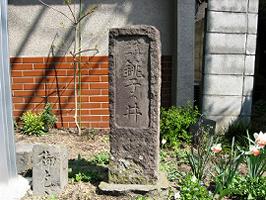
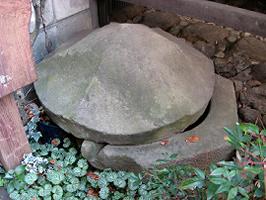
Location: Approximately 100 meters east of Choshoji Temple between Nagoe Road and the railroad tracks.
Story: The well is one of ten that produced clear water of good quality water in old Kamakura: one of the so-called Kamakura Jissei (鎌倉十井), "Ten Wells," whose water was much appreciated by the local people, since the quality of the well water in Kamakura in those days left something to be desired.
The name of this particular well derived from its shape, which resembles a choshi, a type of ladle used for serving sake.
| Nichiren Koimizu, Nichiren's Miraculous Spring (日蓮乞水) |
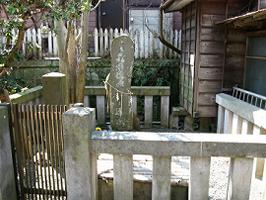
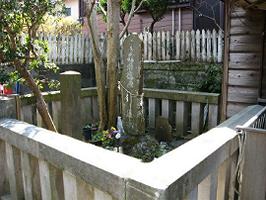
Location: Close to Choshi no I Well.
Story: The spring is one of the Kamakura gomeisui (鎌倉五名水), the five sources of pure water in old Kamakura.
In May of 1253, we are told, Nichiren came to Kamakura to propagate his teachings. While walking in the area, he suddenly became thirsty and, finding no water nearby, stuck his walking staff into the ground, causing water to well out. The well has never produced much water, but neither has it ever run dry even during a drought.
| Nagoe Kiridoshi, Nagoe Pass(名越切通し) |
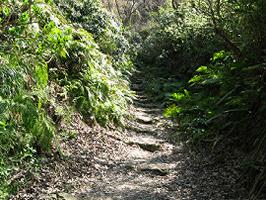
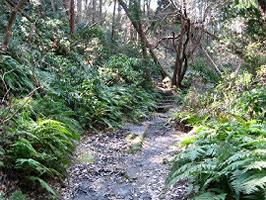
Location: 1.5 kilometers southeast of JR Kamakura Station. On the Kamakura-Zushi border above the Yokosuka Line railroad tunnel.
Site: Nagoe Pass, one of seven passes in old Kamakura, was an important link between Kamakura and the Miura Peninsula.
The pass is reached by taking the path running parallel to the Yokosuka Line on the left when facing Zushi. It is rough and rocky, densely overshadowed by trees, and at its end are two large moss-covered rocks that nearly block the way.
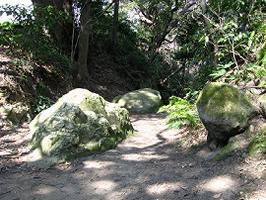
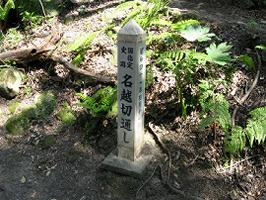
On the left stands a guidepost which says, "Nagoe Pass. Government-designated Historic Site." A sidepath to the left leads to Okirigishi (大切岸), "Huge Hewn Cliff") and eventually to Hisagi-Highland (久木ハイランド) in Zushi. Halfway along the path and on the left are two small stone structures in a style rarely seen, and were apparently created long ago as a memorial of some kind.
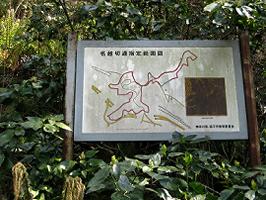
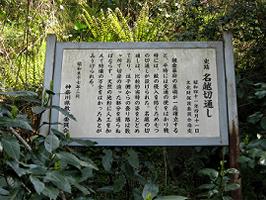
On the path with the guidepost, a 60-meter walk leads to an open space where another guidepost, this one erected by the Kanagawa Prefecture Board of Education (神奈川県教育委員会) reads "Soon after the Kamakura bakufu was founded, seven passes were created for the defense of the city against possible attack and, at the same time, to provide passages in and out of Kamakura in peacetime.
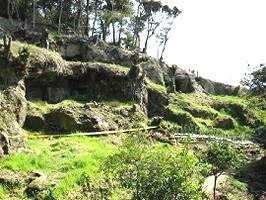
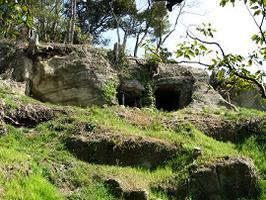
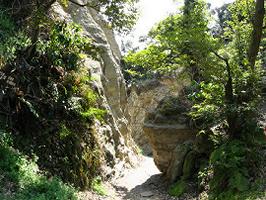
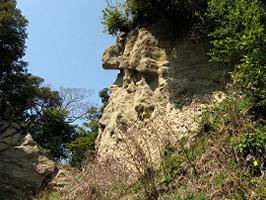
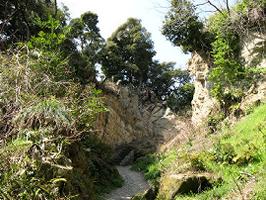
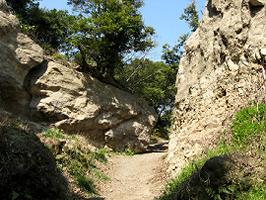
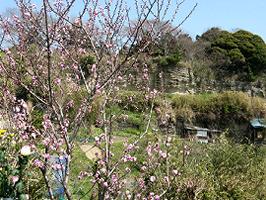
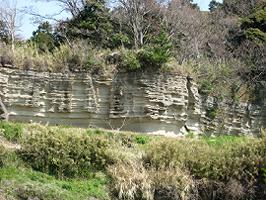
Over the centuries, the surroundings have changed radically but even now Nagoe Pass retains much of its original appearance. Climbing the pass from the Zushi side requires a walk between towering man-made cliffs (kirigishi, 切岸), in several places, and traces of the defensive undertaking, in which the geological features were fully utilized, are still visible."
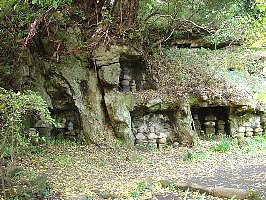
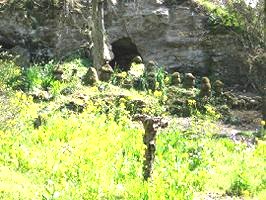
Further ahead from the guidepost is a flight of steps that lead to Mandarado yagura (まんだら堂やぐら) Caves. A little further on toward Zushi, two rocks jut out overhead on both sides. The larger rock is called Ohoto (大空洞) and the smaller one Kohoto (小空洞). Especially prominent here is the deep sense of history evoked by the surroundings.